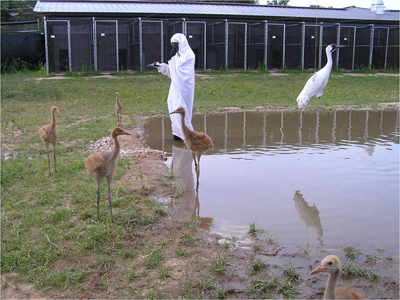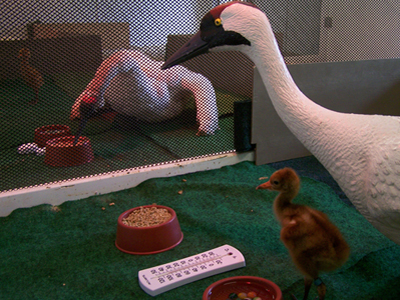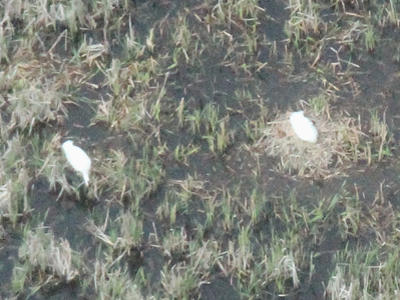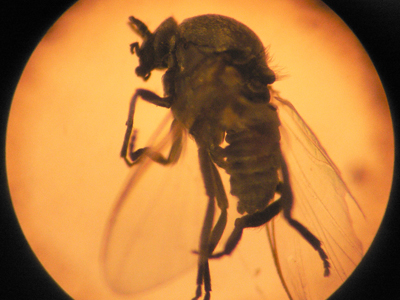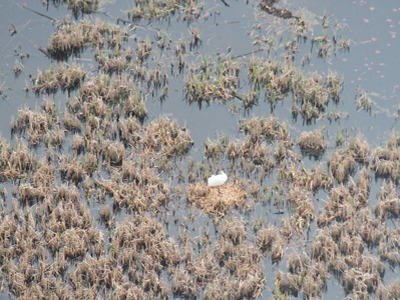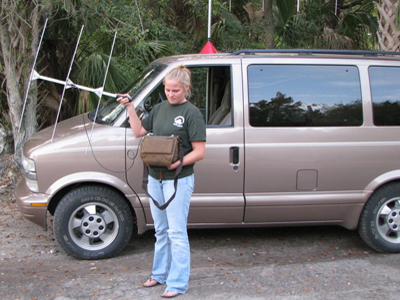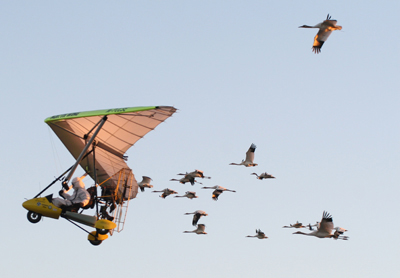 In mid-June we enjoyed another magical night at the International Crane Foundation. An Evening with the Cranes drew friends from across the country to share wine, food, and song from the crane regions of the world, under a beautiful summer sky.
In mid-June we enjoyed another magical night at the International Crane Foundation. An Evening with the Cranes drew friends from across the country to share wine, food, and song from the crane regions of the world, under a beautiful summer sky.
Tag: Whooping Crane
2012 Crane Chick Cam Stars Prepare for Next Stage
 For over eight weeks, the International Crane Foundation (ICF) has broadcast the lives of nine Whooping Crane chicks and their costumed caretakers via our Crane Chick Cam, allowing the public to go behind-the-scenes into the complex world of reintroducing this highly imperiled species in eastern North America.
For over eight weeks, the International Crane Foundation (ICF) has broadcast the lives of nine Whooping Crane chicks and their costumed caretakers via our Crane Chick Cam, allowing the public to go behind-the-scenes into the complex world of reintroducing this highly imperiled species in eastern North America.
Chick It Out! ICF Launches Whooping Crane Chick Cam
 Access to the rare and endangered Whooping Crane chicks that are raised each year at the International Crane Foundation (ICF) in Baraboo, WI is granted only to trained ICF staff wearing crane costumes – until now. This chick season ICF is sharing this experience with the world through our live web cam!
Access to the rare and endangered Whooping Crane chicks that are raised each year at the International Crane Foundation (ICF) in Baraboo, WI is granted only to trained ICF staff wearing crane costumes – until now. This chick season ICF is sharing this experience with the world through our live web cam!
Wild Whooping Crane Chick Hatches in Central Wisconsin
 The Whooping Crane Eastern Partnership (WCEP) is celebrating another success in its efforts to reintroduce a wild migratory Whooping Crane population in eastern North America. A Whooping Crane chick hatched yesterday in Wood County, Wis.
The Whooping Crane Eastern Partnership (WCEP) is celebrating another success in its efforts to reintroduce a wild migratory Whooping Crane population in eastern North America. A Whooping Crane chick hatched yesterday in Wood County, Wis.
Whooping Crane Shot in South Dakota
 ICF is saddened to report on the fatal shooting of a Whooping Crane in South Dakota. The migrating adult crane was from the Aransas/Wood Buffalo population and was traveling with two Whooping Cranes when it was shot with a rifle while standing in a corn field. Law enforcement officers with the U.S. Fish & Wildlife Service (FWS) and the South Dakota Department of Game, Fish and Parks are investigating the shooting which took place on April 20, 2012.
ICF is saddened to report on the fatal shooting of a Whooping Crane in South Dakota. The migrating adult crane was from the Aransas/Wood Buffalo population and was traveling with two Whooping Cranes when it was shot with a rifle while standing in a corn field. Law enforcement officers with the U.S. Fish & Wildlife Service (FWS) and the South Dakota Department of Game, Fish and Parks are investigating the shooting which took place on April 20, 2012.
Black Flies, Fake Nests and Planes!
 ICF’s Field Ecology Department (FED) staff are continuing their study of nesting Whooping Cranes in central Wisconsin and factors that may lead to nest abandonment. One hypothesis is that biting black flies may be harassing the cranes, to the extent that the birds cannot remain on their nest for the full 30-day incubation period. Following is an account of our spring research involving black flies, insect traps and fake nests, and planes!
ICF’s Field Ecology Department (FED) staff are continuing their study of nesting Whooping Cranes in central Wisconsin and factors that may lead to nest abandonment. One hypothesis is that biting black flies may be harassing the cranes, to the extent that the birds cannot remain on their nest for the full 30-day incubation period. Following is an account of our spring research involving black flies, insect traps and fake nests, and planes!
Spring Migration is Underway for “Class of 2011” Whooping Cranes
 The Whooping Crane Eastern Partnership (WCEP), an international coalition of public and private groups that is reintroducing Whooping Cranes to eastern North America, is pleased to report that last year’s “Class of 2011” Whooping Cranes have all begun their spring migration north.
The Whooping Crane Eastern Partnership (WCEP), an international coalition of public and private groups that is reintroducing Whooping Cranes to eastern North America, is pleased to report that last year’s “Class of 2011” Whooping Cranes have all begun their spring migration north.
The Elusive Whooping Crane #2-11
![]() ICF’s Eva Szyszkoski, Tracking Field Manager for the Whooping Crane Eastern Partnership (WCEP), has been in Alabama banding the group of nine ultralight-led Whooping Cranes, which were released at Wheeler National Wildlife Refuge earlier this month. Last week, Eva was tracking a tenth Whooping Crane (#2-11), who had separated from the other nine juvenile cranes during migration in Wisconsin last October and wintered in Florida. Following is Eva’s report on her attempt to re-capture #2-11 to replace it’s radio transmitter (and news that spring migration has started!).
ICF’s Eva Szyszkoski, Tracking Field Manager for the Whooping Crane Eastern Partnership (WCEP), has been in Alabama banding the group of nine ultralight-led Whooping Cranes, which were released at Wheeler National Wildlife Refuge earlier this month. Last week, Eva was tracking a tenth Whooping Crane (#2-11), who had separated from the other nine juvenile cranes during migration in Wisconsin last October and wintered in Florida. Following is Eva’s report on her attempt to re-capture #2-11 to replace it’s radio transmitter (and news that spring migration has started!).
Ultralight-led Whooping Cranes will be Released on Wheeler NWR
 Nine juvenile Whooping Cranes on their first ultralight-led migration south will be taken to Wheeler National Wildlife Refuge (NWR) in Morgan County, Ala. in the next few days. The nine Whooping Cranes will be placed in travel enclosures and loaded onto vehicles as soon as possible. They will be driven about 70 miles from Winston County, Ala., to Wheeler NWR. The cranes will be temporarily housed in a secure pen, during which time they will be fitted with identification bands and tracking transmitters. The young birds will then be released in the company of other Whooping Cranes that have been wintering at the refuge.
Nine juvenile Whooping Cranes on their first ultralight-led migration south will be taken to Wheeler National Wildlife Refuge (NWR) in Morgan County, Ala. in the next few days. The nine Whooping Cranes will be placed in travel enclosures and loaded onto vehicles as soon as possible. They will be driven about 70 miles from Winston County, Ala., to Wheeler NWR. The cranes will be temporarily housed in a secure pen, during which time they will be fitted with identification bands and tracking transmitters. The young birds will then be released in the company of other Whooping Cranes that have been wintering at the refuge.
Aransas Refuge Reports on Whooping Crane Status in Texas
 This has been a busy month for Whooping Crane activity since our last report. Aransas National Wildlife Refuge has received an additional 0.72 inches of precipitation and salinity levels remain higher than ideal. We have continued to help alleviate the low food resources by adding to our prescribed burn totals. This week alone we have burned an additional 4,682 acres of Whooping Crane habitat. Biologists observed the Whooping Cranes eating roasted acorns and are seeing continued usage.
This has been a busy month for Whooping Crane activity since our last report. Aransas National Wildlife Refuge has received an additional 0.72 inches of precipitation and salinity levels remain higher than ideal. We have continued to help alleviate the low food resources by adding to our prescribed burn totals. This week alone we have burned an additional 4,682 acres of Whooping Crane habitat. Biologists observed the Whooping Cranes eating roasted acorns and are seeing continued usage.


